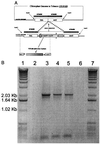Overexpression of the Bacillus thuringiensis (Bt) Cry2Aa2 protein in chloroplasts confers resistance to plants against susceptible and Bt-resistant insects
- PMID: 10051556
- PMCID: PMC26698
- DOI: 10.1073/pnas.96.5.1840
Overexpression of the Bacillus thuringiensis (Bt) Cry2Aa2 protein in chloroplasts confers resistance to plants against susceptible and Bt-resistant insects
Abstract
Evolving levels of resistance in insects to the bioinsecticide Bacillus thuringiensis (Bt) can be dramatically reduced through the genetic engineering of chloroplasts in plants. When transgenic tobacco leaves expressing Cry2Aa2 protoxin in chloroplasts were fed to susceptible, Cry1A-resistant (20,000- to 40,000-fold) and Cry2Aa2-resistant (330- to 393-fold) tobacco budworm Heliothis virescens, cotton bollworm Helicoverpa zea, and the beet armyworm Spodoptera exigua, 100% mortality was observed against all insect species and strains. Cry2Aa2 was chosen for this study because of its toxicity to many economically important insect pests, relatively low levels of cross-resistance against Cry1A-resistant insects, and its expression as a protoxin instead of a toxin because of its relatively small size (65 kDa). Southern blot analysis confirmed stable integration of cry2Aa2 into all of the chloroplast genomes (5, 000-10,000 copies per cell) of transgenic plants. Transformed tobacco leaves expressed Cry2Aa2 protoxin at levels between 2% and 3% of total soluble protein, 20- to 30-fold higher levels than current commercial nuclear transgenic plants. These results suggest that plants expressing high levels of a nonhomologous Bt protein should be able to overcome or at the very least, significantly delay, broad spectrum Bt-resistance development in the field.
Figures





References
-
- MacIntosh S C, Stone T B, Sims S R, Hunst P L, Greenplate J T, Marrone P G, Perlak F J, Fischhoff D A, Fuchs R L. J Invertbr Pathol. 1990;56:258–266. - PubMed
-
- Gould F, Tabashnik B. In: Now or Never: Serious New Plans to Save a Natural Pest Control. Mellon M, Rissler J, editors. Cambridge, MA: Union of Concerned Scientists Publications Department; 1998. pp. 67–106.
-
- Tabashnik B E, Cushing N L, Finson N, Johnson M W. J Econ Entomol. 1990;83:1671–1676.
-
- Gould F. Annu Rev Entomol. 1998;43:701–726. - PubMed
-
- McBride K E, Svab Z, Schaaf D J, Hogan P S, Stalker D M, Maliga P. Bio/Technology. 1995;13:362–365. - PubMed
Publication types
MeSH terms
Substances
LinkOut - more resources
Full Text Sources
Other Literature Sources

